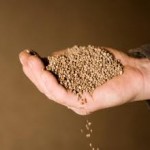* Slowing consumption to hurt sales of Indian companies
* Weak demand to trim India’s potash, phosphate imports
* Urea consumption seen steady on lower prices
* Fertiliser subsidy to stay within limits on weak demand
By Rajendra Jadhav and Kaustubh Kulkarni
MUMBAI, Sept 3 (Reuters) – India’s fertiliser demand is likely to fall nearly a fifth to 45 million tonnes in 2012/13 on record high prices of some soil nutrients and a drought in key cash crop-growing areas.
The first year-on-year drop in consumption in five years is likely to hurt crop yields and sales of fertiliser companies, although it will help the government cap the fertiliser subsidy — one of the reasons behind India’s high fiscal deficit.
“Consumption has been hit badly. So far we have seen a 50 percent drop in potash sales and 30 percent fall in phosphate sales,” said U.S. Awasthi, managing director, Indian Farmers Fertiliser Co-operative Ltd, the country’s top fertiliser maker.
Fertiliser demand is likely to fall to 45 million tonnes in the current financial year ending March, from a record high 54.6 million tonnes a year ago, he said.
Indian fertiliser makers have substantially raised prices of diammonium phosphate (DAP) and muriate of potash (MoP) to record highs from April as global prices jumped while the Indian rupee fell nearly 9 percent against the dollar.
Also, the government slashed subsides for DAP and MoP by 27.4 percent and 10 percent respectively for the current financial year.
“Due to higher prices, some sort of resistance is there and people have rationalised application of DAP and MoP,” said Ashok Ghasghase, director-marketing, at state-run Rashtriya Chemicals and Fertilizers Ltd.
Scanty rainfall in key crop growing states like Gujarat, Maharashtra, Punjab and Karnataka further depressed sentiment.
“Due to erratic rains, farmers are very cautious in using fertilisers. Application of high-cost fertiliser is a risk for them. If rainfall fails, they will end up making bigger losses,” said Tarun Surana, an analyst at Sunidhi Securities & Finance.
Poor demand is likely to affect the profitability of Indian fertiliser firms such as RCF, Tata Chemicals, National Fertilisers, GSFC, Coromandel International and Chambal Fertilisers and Chemicals.
India, a leading producer of key crops, usually sees a drop in crop yields in drought years, and this year a fall in fertiliser usage can further trim yields, said Vedika Narvekar, a senior analyst with Angel Commodities Broking.
UREA CONSUMPTION
State-controlled prices of urea remained unchanged, while that of deregulated DAP and MoP surged. This widened the price difference between urea and other fertilisers.
“Urea consumption should remain at levels that of last year… because of higher phosphate and potash prices, the requirement has shifted to urea,” said Ghasghase at RCF.
For years, the Indian fertiliser industry has been trying to persuade farmers to rationalise urea usage as in many areas they had been using it excessively without applying potash, phosphate and sulphur in required amounts.
Slowing demand for fertiliser is already pinching global suppliers as India imports all its potash and also buys about 90 percent of its phosphate from abroad.
“Our import requirement has gone down due to falling demand,” Awasthi said.
The country had signed import deals for over 6 million tonnes MoP in 2011/12 and more than 7 million tonnes of DAP.
Potash Corp, Mosaic Co, Agrium Inc , Uralkali, ICL Israel Chemicals and K+S are among the major potash suppliers to India.
Morocco’s Office Cherifien des Phosphates, PhosChem and Russia’s Phosagro are key DAP suppliers to India.
The demand slump caused by poor rainfall during kharif, or summer-sown crop, season is irreversible, but the industry is now hoping for a normal rabi, or winter-sown crop, season.
“As of now, northern states are getting good rains. If this kind of scenario continues, probably it will help maintain normal demand during rabi season,” Ghasghase said.
The Indian government usually pays a higher subsidy on fertilisers than intial budget estimates.
This year is likely to be an exception with a sharp drop in consumption enabling the government to retain subsidy at the 609.7 billion rupees ($10.96 billion) estimated in the budget, said an industry official, who declined to be named.
($1 = 55.6 rupees) (Editing by Sunil Nair)







